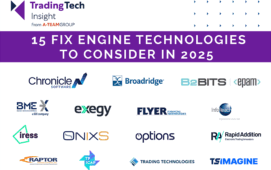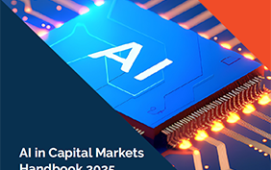
OpenAI’s release of GPT-5 yesterday is likely to trigger a fundamental shift in the conversation around AI on the trading floor. The focus is now less on the model’s raw intelligence or “IQ,” but more on something far more critical for financial markets: control, reliability, and governance. The industry is finally moving beyond speculative chatbots and toward deployable, governed agents that can operate safely within the high-stakes, highly-regulated environment of wholesale markets.
For years, the adoption of advanced AI has been stalled by a single, immovable obstacle: risk. The blocker for regulated firms such as banks, brokers, and asset managers was never a lack of creative potential, but the inability to guarantee reliable execution inside compliant workflows that demand strict audit trails, hard limits, and predictable outputs. With the advent of models like GPT-5, the industry is poised to move from siloed experiments in innovation “labs” to production-grade agents embedded directly into the fabric of trading and operations.
From Unpredictable to Enterprise-Ready
So what’s actually new in GPT-5? The true innovation lies not just in a more powerful model, but in the enterprise-grade controls that GPT-5 consolidates and advances to allow firms to govern precisely how it works. The latest systems introduce adaptive reasoning paths and variable compute that intelligently balance speed and depth, answering simple queries quickly while dedicating more computational thought to complex tasks. This resolves the persistent trade-off that has plagued research and operations use cases.
For platform owners and developers, this is paired with far tighter controls. New parameters allow teams to dial model behaviour for speed or depth, while a cleaner, more robust contract for tool-calling strengthens the bridge between the AI and a firm’s proprietary systems. This paves the way for sophisticated agents capable of orchestrating multi-step tasks – such as browsing a research portal, extracting key data, and summarising findings – all while operating under explicit, human-in-the-loop approval gates.
Crucially, this is all backed by features that speak directly to risk and compliance. For years, getting structured data from an AI was a high-risk gamble. Models would return data like a JSON object wrapped in conversational text (e.g., “Certainly, here is the data you requested…”) and often riddled with small formatting errors. This forced developers into a high-stakes clean-up routine known as regex post-processing – using complex pattern-matching rules (Regular Expressions) to find and extract the usable data. This process is notoriously brittle; a minor, unannounced change in the model’s phrasing could break the clean-up code and corrupt data flowing into downstream systems.
Structured Outputs in GPT-5 lets you define a JSON schema the model must follow. The API validates responses and returns either schema-conformant JSON or an explicit error, which greatly reduces “JSON-ish” output and the need for brittle post-processing. While not strictly deterministic, this approach provides schema-validated, machine-readable data suitable for piping into trading or risk systems when combined with standard validation and retries. In enterprise deployments via the OpenAI API or Azure OpenAI, customer prompts and outputs are not used to train models by default, helping keep proprietary information private.
Where New Capabilities Will Land First
The initial applications for these governed agents will target areas where manual, time-consuming data aggregation is a significant drain on high-value staff. The key to unlocking these use cases is the ability to prove, with certainty, how an agent arrived at its conclusions.
On the sell-side, governed agents can transform pre-trade workflows. A sales-trader’s client brief can be auto-generated by an agent that pulls approved holdings, market data, and house views from integrated systems, with all CRM updates requiring human sign-off. The process is made safe and auditable by a platform-level log that records every tool call, parameter, and user action in a tamper-evident transcript. This provides reconstructible proof of data lineage, satisfying both compliance and vendor licensing requirements. The same audit-first approach applies to structuring desks; an agent can draft term sheets and run scenarios, while the log transparently records every pricing model and client constraint applied, ensuring a clear path to final human approval.
For the buy-side, the most immediate impact will be on research synthesis at scale. Agents can automate the review of broker research and filings, generating daily “what moved my thesis” summaries with full citations. The agent’s tool-call log goes a step further, providing an auditable trail that proves exactly which documents were accessed and what specific data points were extracted to generate the summary, transforming a “black box” into a transparent research assistant. This efficiency extends to technical teams; quant and platform engineering co-pilots can now accelerate code refactoring and back-test harness creation, with the log providing a clear record of the agent’s contributions for code reviews.
This “agent-inside” paradigm will also reshape the offerings of market infrastructure providers and ISVs. Instead of a separate AI tool, vendors will embed governed agents directly into OMS/EMS and surveillance platforms. This will allow users to translate natural-language intent – like “show me probable spoofing clusters” – into structured queries and auto-generated case files with verifiable data provenance. This provenance is not just a vague promise; it means every alert or case file can be traced back through a detailed tool-call log to the raw data and specific analytical tools that generated it, providing the granular detail required for regulatory inquiries.
A Blueprint for Deploying Without Breaking Governance
Putting this into practice requires a new architectural blueprint built around security and observability. Whether using OpenAI’s API or Microsoft’s Azure AI Studio, the foundation is a secure environment where model versions are pinned and all settings are meticulously logged.
In such a design, a thin agent gateway mediates GPT-5’s tool use and access to the outside world. It operates on a “least-privilege” principle, giving the agent access only to a pre-approved list of read-only tools like data fetchers. For any action that writes to a system or sends an external communication, the gateway enforces a critical safeguard: it routes the request through a specific tool that requires explicit human approval before proceeding. Similarly, before releasing any free-text output like an email, the gateway performs automated policy checks, scanning for restricted language, missing disclaimers, or potential data entitlement issues.
Underpinning this entire framework is the audit trail. The platform captures a detailed, re-playable transcript of every interaction, including prompts, tool calls, model versions, and user identities, and stores it in tamper-evident, write-once storage. This provides the reconstructible evidence needed for rigorous model-risk management and compliance review.
The key is to start with safe, read-only datasets and enforce human approval, while simultaneously building the governance framework and deciding on a long-term hosting path. As firms build confidence, these point solutions will evolve into a shared agent platform, with central policies, cost routing, and reusable tool catalogues. Surveillance, market-abuse reconstruction, and regulatory reporting will become natural second-wave targets as the reliability of Structured Outputs and approval gates is proven in production.
To prepare, technology leaders should be asking their vendors critical questions this quarter:
- Tool Discipline: Which of your workflows are agent-enabled, and how do you whitelist tools with least-privilege scopes?
- Determinism: Where are you using Structured Outputs, and can you share your JSON Schemas?
- Auditability: Can we replay an agent task end-to-end, capturing the model version, prompts, tool calls, and human approvals?
- Residency: Do you support both OpenAI Enterprise and Azure AI Foundry deployments with UK/EU data-zone options?
The bottom line is clear. The significance of GPT-5 for wholesale markets is not “more IQ.” It’s the ability to run governed agents that produce schema-safe outputs, call only approved tools, and leave an audit trail that satisfies supervisors. By framing adoption around these robust constraints and measuring the real-world gains in cycle time and quality, firms can finally move generative AI from the demo to the desk.
Subscribe to our newsletter




